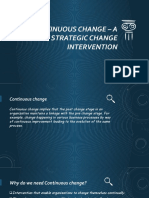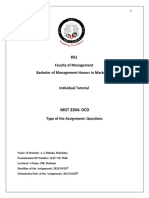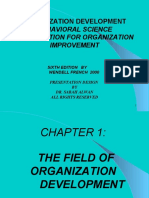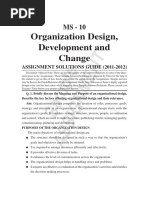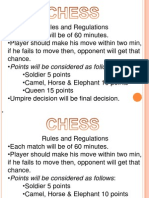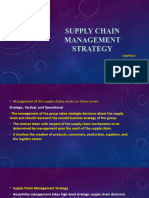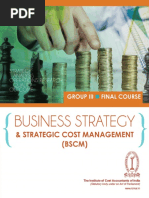Lectures For Od
Lectures For Od
Uploaded by
kylaagting22Copyright:
Available Formats
Lectures For Od
Lectures For Od
Uploaded by
kylaagting22Original Title
Copyright
Available Formats
Share this document
Did you find this document useful?
Is this content inappropriate?
Copyright:
Available Formats
Lectures For Od
Lectures For Od
Uploaded by
kylaagting22Copyright:
Available Formats
WEST COAST COLLEGE, INC.
Pio Duran, Albay
S. Y. 2024-2025
1st Semester
LECTURES FOR ORGANIZATIONAL DEVELOPMENT
MANAGEMENT – It is the process of managing resources efficiently and effectively.
EFFICIENT – Doing things right. Performing ones task with minimal resources, less
time
and effort.
EFFECTIVE - Doing the right things. Your performance is achieving the goals of a
company.
LEVELS OF MANAGEMENT:
TOP LEVEL - executives like CEO
MIDDLE LEVEL –positions/sale staff
FRONT LEVEL - operational staff
MANAGEMENT SKILLS :
TECHNICAL SKILLS-Performing special tasks. Ex. engineers, accountant
INTERPERSONAL SKILLS-Ability to lead, motivate, encourage, communicate
CONCEPTUAL SKILLS-Analytical, can identify, can think abstract to solutions to
complex
problems
DECISION MAKING SKILLS – Can decide intelligently and the decisions are aligned
to the
goals of the company
RESOURCES OF AN ORGANIZATION:
1. HUMAN RESOURCES
2. FINANCIAL RESOURCES
3. PHYSICAL RESOURCES
3. INFORMATIONAL RESOURCES
THE 5 M’s of MANAGEMENT: Man, Material, Machines, Methods and Money
ORGANIZATION – It is an organized group of people performing a specific task to realize
the
goals of a company.
ORGANIZATIONAL COMPANY – It is the study and implementation of practices, systems
and
techniques an organizational management.
VALUES OF ORGANIZATIONAL DEVELOPMENT:
1. Promotes continuous development. This is integrating continuous innovation in
a
business to ensure and nurture competitive language. OD lays the foundation pattern
of
improvement and innovation for quality outcomes. In short embracing changes to
succeed in disruptive times.
2. Advocates for employee development. Emphasis in encouraging the
employees to
embrace the required changes in the firm. There is a need to undergo trainings to
improve
their ability to adjust to the variations in the market to improve the performance and
productive output.
3. Aims for quality products and services. This is reinventing the products and
services
for the organizational development. For a firm to compete successfully against other
players
in the market.
4. Enhances the financial performance of the firm. The company can significantly
reduce its expenses due to improved business processes and expand its market as a
result of
developed operating procedures.
5. Promotes and manages growth among firms contributing to a better society.
CHAPTER I
OVERVIEW OF ORGANIZATIONAL DEVELOPMENT
In order for organizations to more effectively respond and adapt to market/
industry challenges and technological advancements, they adopt organizational
development (OD) as part of their business strategy to address these issues. OD refers
to
a planned and systematic scheme of implementing change. Many companies in
different
parts of the world are prosperous because they introduce and employ OD to strengthen
their
agility in handling new difficulties in the marketplace quickly and with little interruption.
LESSON I - DOCTRINE OF ORGANIZATIONAL DEVELOPMENT
Today’s world order among organizations is to continually search for
strategies
on how to deal with CHANGE. Change is constant and it aspects of the organization’s
operations and everyone in it. Organizations that disregard change will eventually die
a
natural death. Entities that manage change will evolve and transform themselves to
adapt
to their unique setting. For an organization to survive, it must be capable of finding
new
ways of doing old things at a pace faster than the changes taking place in the
external environment
With the countless challenges confronting many firms today, they need to
find
novel strategic schemes to overcome these experiences and their possible adverse
effects.
There is no quick formula that will address the challenges brought about by change.
When
Firms anticipate changes, they will build a flexible, dynamic, and sustainable
organization.
One of the tactics that companies adopt to manage change is through organizational
development.
Organizational development entails the utilization of new and innovative
procedures, methods and approaches to handle specific change factors.
OD encompasses the following attributes:
1. OD involves planned stage. This is a systematic and systematic diagnosis
of
an organization.
2. OD entails total system effort. This means that OD is aligned to the
overall
goal of the organization to manage change in a holistic manner rather based on
fragmented efforts.
3. OD leads to improved organizational effectiveness. OD will enhance the
firm’ s ability to adapt to change and invigorate companies amidst the challenges
occurring in the environment.
4. OD calls for the application of behavioral science knowledge. OD
emphasizes
the importance of understanding people’s attitudes, beliefs, and feelings in developing
new methods of improving performance, teamwork, communication, and collaboration.
5. OD requires the support of top management. OD is most effective when
the top management gives its support and approval in the implementation of the
process.
6. OD encompasses problem-solving and a renewal process. OD implies
diagnosis of issues confronting organizations and finding feasible solutions to attain the
self-managed
development and growth.
7. OD relies on an educational strategy. This means that OD focuses on the
human factor to effect planned changes through data feedback, sensitivity training, and
the like.
8. OD implies collaborative relationships. OD entails collective effort and
constant
communication among various internal and external stakeholders of the organization to
implement meaningful changes in the firm.
9. OD is related to the company’s vision and mission. Vision is the statement
of the
desired future of the firm. Mission is the expression of the organization’s reason for
being. Shared vision and mission provide the boundaries with which action and
decision – making take place. They serve as organizational anchor that keep the firm
stable amid an ever-changing environment. OD’s planned changes are always aligned
to these two concepts.
LESSON 2 – EVOLUTION OF ORGANIZATIONAL DEVELOPMENT
The concept of organizational development started after World War II. There
were two significant outcomes from the aftermath of the war. These were the scarcity
of material
Resources and workforce to keep up the efficient production of companies. To
overcome these adverse outcomes of war, firms implemented training programs and
conducted long range planning to optimize the utilization of their limited resources.
Planning and training became the springboard for enhancing organizational and
individual effectiveness.
The evolution of OD is anchored on four trunk stems of organizational
practice.
1. T-group. Kurt Lewin, popularly known as the founding father of OD,
pioneered the use of T-group (sometimes called the sensitivity or laboratory training
groups. This type of involves a small group of participants ranging from8 to 15 people.
The participants used feedback, problem-solving, role play, and other methods to lean
about themselves, others and groups through their interaction with each other. The
ultimate objective of the T-group is to institute change in the standards, attitudes, and
actions of people in an organization.
2. Survey Feedback. The process of survey feedback was initiated by Mann
together with his associates in 1957. This made use of a questionnaire designed to
gather feedback about the different aspects of the organization’s operations.
3. Action Research. It was introduced by Kurt Lewin in the late 1930’s. This
is a process of collecting data through research relative to the concerns in the
organization. The information gathered was used to implement changes within the
system.
4. Socio-technical Theory. This doctrine was formulated by a group of
researchers
led by Eric Trist. They made a study among the workers in a coal mine in South
Yorkshire in 1949. The researchers assessed social and technical aspects or the
interaction between people and technology in specialized job areas. This is to design
jobs to improve quality of life, enhance organizational effectiveness, and encourage
participative management.
The field of OD continues to evolve and adjust to the disruptions in the
environment. OD is considered as a catalyst in transforming organizations and guiding
management’s efforts in handling challenges related with change.
LESSON 3 – STAGES IN THE OD PROCESS
1. Initial Problem Diagnosis. This is gathering information about the nature
of the problems, while at the same time seeking for possible remedies of the said
concerns.
2. Data Collection. This is collecting data about the underlying factors
related to the identified problems. Data gathering is the most important part of the OD
process. The information can be collected by internal stakeholders through the
administration of questionnaires. At other times, data can be obtained by the external
conduct through the conduct of interview.
3. Data Feedback and Confrontation. The top management and the change
agent will review the data as to its bearing to the existence of the problem. Should
there will be disagreements in terms of the analysis of the data, they will find a
common ground to discuss the merits and demerits of the information gathered.
4. Planning the Strategy for Change. The change agent will come up with
recommended actions in the implementation of the change strategies. The goal is to
concretize the outcomes of the problem diagnosis into a doable design.
5. Integrating the Structure. The next step is the implementation of the said
changes into the company’s structure. There can be a laboratory training, process
consultation, conflict resolution and other participative intervention schemes.
6. Team Building. This is for nurturing open communication, trust, and
respect among all the organizational members will be highlighted. This is also a
training ground in cultivating teamwork, collaboration, and cooperation in problem
solving and conflict management.
7. Evaluation. OD is a long and intricate process. There is regular monitoring
of all the activities.
LESSON 4 - SIGNIFICANCE OF OD.
1. OD enables the firm for better respond to environmental changes and
technological l advances.
2. OD helps promote and manage growth in companies.
3. OD helps companies reinvent its products/services.
4. OD facilitates analysis of work processes.
5. OD enhances organizational communication.
6. OD fosters continuous development.
7. OD supports employee development.
PREPARED BY:
ROSALINDA D. BOSQUE, MAEd
Associate Professor REFERENCE: Organizational Development
By: Maria Victoria U. SY,
DM-HRM
You might also like
- Chapter 1 General Introduction To Organization DevelopmentDocument3 pagesChapter 1 General Introduction To Organization DevelopmentLindsay100% (2)
- CBMEC 2 Strategic Management 2021 Syllabus 1Document15 pagesCBMEC 2 Strategic Management 2021 Syllabus 1Ayame Kusuragi100% (1)
- Continuous Change - Team DDocument25 pagesContinuous Change - Team Dsrishti bhatejaNo ratings yet
- Organizational Development Unit 3Document44 pagesOrganizational Development Unit 3Lucky SharmaNo ratings yet
- B05-MGT 3304-5846Document6 pagesB05-MGT 3304-5846Dinuka Dakshina AdikariNo ratings yet
- Org EffectivenessDocument40 pagesOrg EffectivenessshirishNo ratings yet
- Chapter 1 OCDDocument16 pagesChapter 1 OCDMr. Srikanth KNo ratings yet
- Babiera - EffectiveOrg, Strat of OD, & Department - 206 ReportDocument44 pagesBabiera - EffectiveOrg, Strat of OD, & Department - 206 ReportLiel Lelouch Embarca BabieraNo ratings yet
- Organigation DeveDocument3 pagesOrganigation Devemerin sunilNo ratings yet
- Organisation Development Change and Od Interventions 151681893850616Document27 pagesOrganisation Development Change and Od Interventions 151681893850616Mantry PriyatheeNo ratings yet
- OD - Chapters 1-3Document20 pagesOD - Chapters 1-3Atty. Chrismaire Pasky JumagdaoNo ratings yet
- Mba Org Development and Org Change Mayaug2024 Copy 2 As On 11.6.24 PLUS SEPTDEC2024Document122 pagesMba Org Development and Org Change Mayaug2024 Copy 2 As On 11.6.24 PLUS SEPTDEC2024ndunguwilson38No ratings yet
- Organizational DevelopmentDocument13 pagesOrganizational DevelopmentChristian Madduma Guitteng100% (1)
- ED 713 - ORG GROWTHDocument51 pagesED 713 - ORG GROWTHRige Mae MuescoNo ratings yet
- HRM Module 5Document10 pagesHRM Module 5Tanaya BondreNo ratings yet
- A Review: The Structural Intervention and Od'S Future: Gurveen Sandhu, Gurpreet Singh Mann, Rajdeep Kaur VirkDocument3 pagesA Review: The Structural Intervention and Od'S Future: Gurveen Sandhu, Gurpreet Singh Mann, Rajdeep Kaur VirkSukumar ManiNo ratings yet
- Human Resources Management UNIT 30Document9 pagesHuman Resources Management UNIT 30tjnihalNo ratings yet
- Od15 090520060557 Phpapp02Document31 pagesOd15 090520060557 Phpapp02Shubhs TayalNo ratings yet
- Organization 3rd SeminarDocument18 pagesOrganization 3rd SeminarjessyNo ratings yet
- MPOB QuestionsDocument33 pagesMPOB QuestionsTushti MalhotraNo ratings yet
- Unit II - Organizational DesignDocument47 pagesUnit II - Organizational DesignRebekah JNo ratings yet
- Intro To OdDocument8 pagesIntro To OdSankari SNo ratings yet
- Organizational Change and ManagementDocument7 pagesOrganizational Change and ManagementShien AerisNo ratings yet
- ODDocument18 pagesODMeenakshi GodaraNo ratings yet
- Hands Out COyL I - Part 2Document5 pagesHands Out COyL I - Part 2MAFERNo ratings yet
- MG312 CH 1Document9 pagesMG312 CH 1eligamergirl101No ratings yet
- Organisational Change and DevelopementDocument7 pagesOrganisational Change and Developementsindu akileshNo ratings yet
- Organizational DevelopmentDocument6 pagesOrganizational DevelopmentMizan HawladerNo ratings yet
- 123 OdDocument13 pages123 Odexpert3ddesignstudioNo ratings yet
- OD Applications:: Application of OD in Business EnterprisesDocument4 pagesOD Applications:: Application of OD in Business EnterprisesJitendra KumarNo ratings yet
- Cap Int T4Document39 pagesCap Int T4Johann BonillaNo ratings yet
- Lesson 125Document5 pagesLesson 125Gurukant PawarNo ratings yet
- Lesson 1 Hrmp7 Organization Devt 2nd Sem Sy2022 2023Document5 pagesLesson 1 Hrmp7 Organization Devt 2nd Sem Sy2022 2023John Ace CorsameNo ratings yet
- Organizational Development and Change Management All Units (1)Document66 pagesOrganizational Development and Change Management All Units (1)Balu HariNo ratings yet
- OMPLETE-NOTES (1)_6903195Document137 pagesOMPLETE-NOTES (1)_6903195sejokap977No ratings yet
- Organisation Development-Kotak Mahindra - AFFANDocument87 pagesOrganisation Development-Kotak Mahindra - AFFANRajendra Babu DaraNo ratings yet
- Organization and Management Lecture NotesDocument16 pagesOrganization and Management Lecture NotesMORADA, JIEZAH CARLA B.No ratings yet
- Part 2-Essential Management Functions Chapter V. Organizing Business ActivitiesDocument13 pagesPart 2-Essential Management Functions Chapter V. Organizing Business ActivitiesEunice CatubayNo ratings yet
- Chapter 1 - Introduction To ManagementDocument29 pagesChapter 1 - Introduction To ManagementfaakhirahNo ratings yet
- Report - Human BehaviorDocument38 pagesReport - Human BehaviorMyries Alido BungagNo ratings yet
- Retail ManagementDocument15 pagesRetail ManagementMohini MalakarNo ratings yet
- I Assignment OcdDocument4 pagesI Assignment OcdNeha JainNo ratings yet
- Dmgt520 Organization Change and DevelopmentDocument205 pagesDmgt520 Organization Change and DevelopmentBaltej singhNo ratings yet
- Characteristics of Organization DevelopmentDocument5 pagesCharacteristics of Organization DevelopmentroshanNo ratings yet
- Section: Organization Development Unit - I - ADocument31 pagesSection: Organization Development Unit - I - AAilyn NaragaNo ratings yet
- Organization Development and Change Final Bring Home ExamDocument6 pagesOrganization Development and Change Final Bring Home Examjoseph carl maglinteNo ratings yet
- Assignment Mu0011 Mba 3 Spring 2014Document12 pagesAssignment Mu0011 Mba 3 Spring 2014Mandar RaneNo ratings yet
- Organization DevelopmentDocument37 pagesOrganization DevelopmentVenugopalNo ratings yet
- Change Management PreparationDocument18 pagesChange Management PreparationPranjalNo ratings yet
- Organization Design, Development and Change: M E N TDocument13 pagesOrganization Design, Development and Change: M E N Tarun1974No ratings yet
- Organizational ChangeDocument136 pagesOrganizational ChangeAnanya RayNo ratings yet
- Organizations DevelopmentDocument25 pagesOrganizations DevelopmentSuleymen Abdureman OmerNo ratings yet
- Introduction of Management LeadershipDocument130 pagesIntroduction of Management LeadershipprashantNo ratings yet
- Organization and ManagementDocument8 pagesOrganization and ManagementMhar GinezNo ratings yet
- Organisational DevelopmentDocument21 pagesOrganisational DevelopmentShadab KhanNo ratings yet
- Organization Development: Concept and Process: - Tarak Bahadur KC, PHDDocument22 pagesOrganization Development: Concept and Process: - Tarak Bahadur KC, PHDAnonymous Q8c4ljfZOCNo ratings yet
- Business Management Principles for Today's Leaders: A Practical Guide for ProfessionalsFrom EverandBusiness Management Principles for Today's Leaders: A Practical Guide for ProfessionalsNo ratings yet
- The Power of Habit Stacking: Change Management and Organizational ChangeFrom EverandThe Power of Habit Stacking: Change Management and Organizational ChangeNo ratings yet
- Building Winning Organisations: A complete guide to sustaining best-in-class performance for all organisationsFrom EverandBuilding Winning Organisations: A complete guide to sustaining best-in-class performance for all organisationsNo ratings yet
- EP MergedDocument124 pagesEP Mergedsydney augustNo ratings yet
- IB Group AssignmentDocument4 pagesIB Group AssignmentGUDATA ABARANo ratings yet
- Case Study Rita DressesDocument30 pagesCase Study Rita DressesSmriti KhannaNo ratings yet
- Group Assignment: Vietnam Maritime UniversityDocument17 pagesGroup Assignment: Vietnam Maritime UniversityGinibo AghoghoNo ratings yet
- Stratma - Case Study (Jason Laurente)Document3 pagesStratma - Case Study (Jason Laurente)Joland Cosipag Orenda100% (1)
- Managing Strategic ChangeDocument5 pagesManaging Strategic Changerajendrakumar0% (1)
- Force Field Analysis in Change ManagementDocument15 pagesForce Field Analysis in Change Managementn02221351yNo ratings yet
- Introduction To Ammunition Service Support Structure 55B40A02 1.0. GeneralDocument60 pagesIntroduction To Ammunition Service Support Structure 55B40A02 1.0. GeneralMalikHodzicNo ratings yet
- pg21 40 PDFDocument20 pagespg21 40 PDFsarwat bNo ratings yet
- UOE Strategic ManagementDocument21 pagesUOE Strategic ManagementFaith PatrickNo ratings yet
- Dissertation Approval SheetDocument7 pagesDissertation Approval SheetHelpWritingPapersCanada100% (2)
- 7-S Framework - A Checklist With Initiatives and MetricsDocument15 pages7-S Framework - A Checklist With Initiatives and MetricsQuickly BrandNo ratings yet
- Workforce AnalyticsDocument22 pagesWorkforce AnalyticsNafizAlam100% (1)
- CONTANT FOR WEBSITE UPON SOLUTIONDocument4 pagesCONTANT FOR WEBSITE UPON SOLUTIONtoxitob649No ratings yet
- ROOT CAUSE FAILURE ANALYSIS (RCFA) ----------1 (1)Document344 pagesROOT CAUSE FAILURE ANALYSIS (RCFA) ----------1 (1)jide.atolagbe3737No ratings yet
- Chess RulesDocument8 pagesChess RulesZahid HassanNo ratings yet
- McDonald N. - Starting Out The English 2003 PDFDocument193 pagesMcDonald N. - Starting Out The English 2003 PDFMayara JulianNo ratings yet
- Strategic Management: Karakteristik Manajemen StrategiDocument25 pagesStrategic Management: Karakteristik Manajemen StrategiriskaNo ratings yet
- Evaluation of Progress and Outcome of Care: SERRANO, Jimuel FDocument29 pagesEvaluation of Progress and Outcome of Care: SERRANO, Jimuel FLiza AingelicaNo ratings yet
- Complete Kano State Youth PolicyDocument82 pagesComplete Kano State Youth PolicyOnuhNo ratings yet
- KV - Stock Market 2024 COURSE FEATURES & OUTCOMESDocument7 pagesKV - Stock Market 2024 COURSE FEATURES & OUTCOMESdhanasekarmanojkrishnaNo ratings yet
- Marketing Management & StrategyDocument18 pagesMarketing Management & StrategyGRACE MATIUS STUDENTNo ratings yet
- ACCA FIA - Management Accounting (MA) - Teaching Slides - 2019Document1,041 pagesACCA FIA - Management Accounting (MA) - Teaching Slides - 2019Jerlin PreethiNo ratings yet
- Ritual Discourse in RPG'S: Christopher I. LehrichDocument23 pagesRitual Discourse in RPG'S: Christopher I. LehrichMagdalena SzczepockaNo ratings yet
- Chapter 3 Supply ChainDocument19 pagesChapter 3 Supply ChainChristian Steve TerencioNo ratings yet
- Final-Paper15 Straegy AnalysisDocument922 pagesFinal-Paper15 Straegy AnalysisSukumar100% (2)
- Chapter 1 To 5Document40 pagesChapter 1 To 5Rachele VidalNo ratings yet
- BSR Stakeholder Engagement SeriesDocument14 pagesBSR Stakeholder Engagement Seriestri17No ratings yet
- ApproachDocument10 pagesApproachFathimaNo ratings yet


